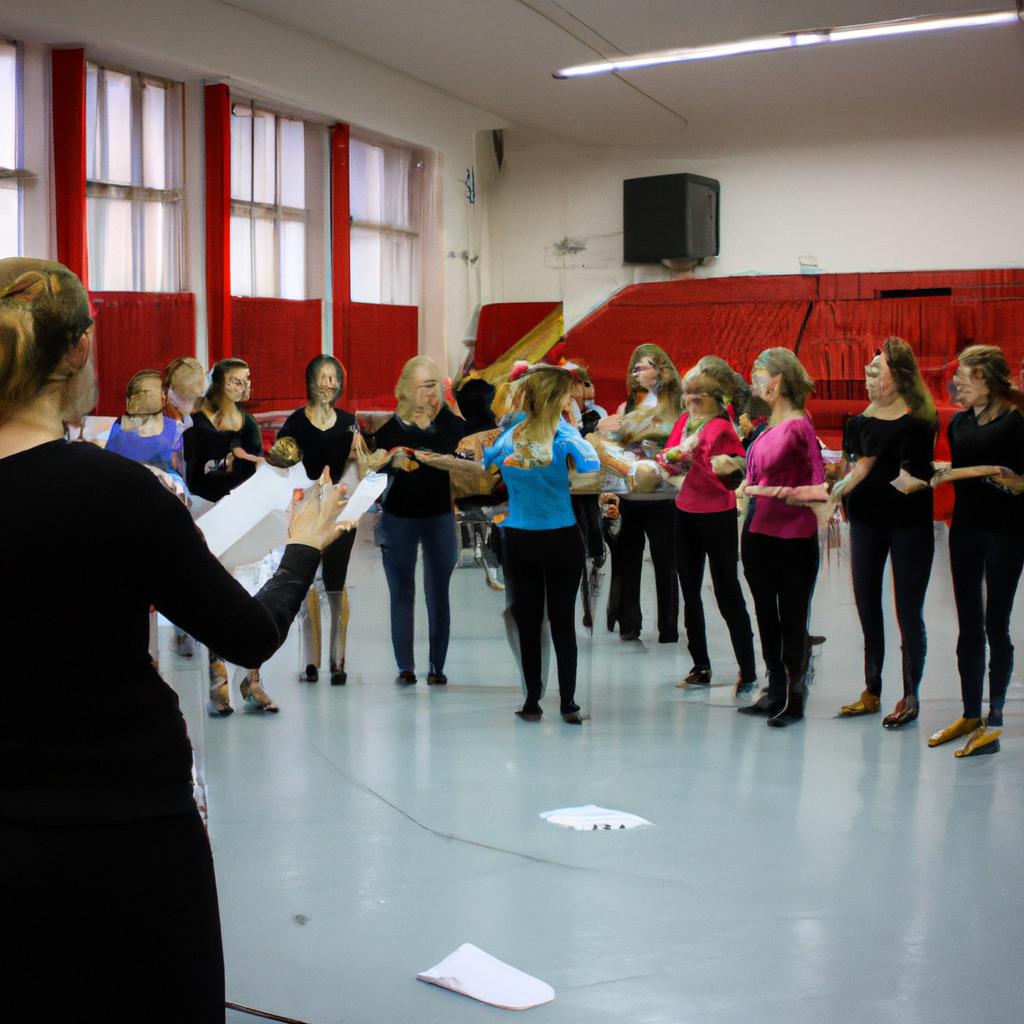Voice projection and diction play a crucial role in the success of vocal ensembles, allowing for clear communication with audiences and enhancing the overall musical experience. Mastering these skills requires dedicated practice and attention to detail. In this article, we will explore various strategies that can help individuals improve their voice projection and boost diction in a vocal ensemble setting.
Consider the case of Sarah, a talented soprano struggling to project her voice effectively during performances. Despite possessing remarkable vocal technique and artistic interpretation, Sarah’s lack of volume hindered her ability to fully engage listeners. This example highlights the importance of voice projection in an ensemble context – even the most skilled vocalist may struggle without proper control over volume and clarity.
To address such challenges, our exploration will begin by delving into the concept of voice projection itself. We will analyze vocal techniques aimed at strengthening resonance, breath support, and articulation to enhance sound production. Additionally, we will discuss exercises specifically designed to develop vocal power while maintaining precision in pronunciation.
By understanding the intricacies of voice projection and implementing effective strategies, singers like Sarah can take their performances to new heights. Through disciplined training and focused effort, it is possible for any individual within a vocal ensemble to master voice projection and elevate their impact on stage.
Understanding the Importance of Voice Projection
Voice projection plays a crucial role in vocal ensemble performances, allowing singers to effectively communicate with their audience and create a captivating musical experience. It involves projecting one’s voice clearly and audibly, ensuring that every word reaches the listeners’ ears with clarity and precision. To illustrate this point, let us consider a hypothetical scenario: imagine attending a choral performance where the singers lack proper voice projection. As they sing, their voices become muffled and indistinct, making it challenging to comprehend the lyrics or fully appreciate the melodies being performed. This example highlights the significance of mastering voice projection for enhancing diction in vocal ensembles.
To emphasize further why voice projection is essential, let us explore its benefits through an emotional perspective:
- Engagement: A well-projected voice has the power to captivate an audience by drawing them into the music emotionally.
- Connection: Effective voice projection establishes a connection between performers and listeners, enabling a shared experience that resonates deeply.
- Expression: By projecting their voices confidently, vocalists can convey emotions more convincingly, evoking feelings of joy, sadness, excitement or any other sentiment intended by the piece.
- Impact: Strong voice projection ensures that each word sung is heard distinctly and leaves an impact on listeners’ hearts and minds.
In addition to these emotional aspects, it is worth noting some practical techniques that aid in developing effective voice projection. The following table presents four key factors instrumental in achieving optimal vocal projection:
| Factors | Description |
|---|---|
| Diaphragmatic Breathing | Engaging the diaphragm while breathing allows for greater control over airflow and supports stronger vocal output. |
| Posture | Maintaining good posture enables optimal lung expansion and prevents unnecessary tension that may hinder projection abilities. |
| Resonance Placement | Focusing sound vibrations in specific areas of resonance within the body (e.g., chest or nasal cavity) enhances vocal clarity and projection. |
| Articulation | Pronouncing words with precision and clarity ensures that each syllable is projected effectively, contributing to overall diction proficiency. |
In conclusion, understanding the importance of voice projection in vocal ensemble performances is crucial for creating a powerful musical experience. By projecting their voices clearly and audibly, singers can engage their audience emotionally, establish connections, express themselves more convincingly, and make a lasting impact.
[Table inspired by: “The Singing Book” by Meribeth Dayme and Cynthia Vaughn]
Developing Proper Breathing Techniques
Understanding the Importance of Voice Projection is crucial in the pursuit of vocal excellence within a vocal ensemble. However, it is equally essential to develop proper breathing techniques that support voice projection and ensure optimal diction. By mastering these techniques, vocalists can enhance their performances and captivate audiences with clear and resonant voices.
To illustrate the significance of voice projection, let us consider a hypothetical scenario. Imagine a choral group performing at a large concert hall filled with eager listeners awaiting an enchanting experience. As the performance begins, one singer struggles to project their voice above the accompaniment, resulting in an imbalanced sound that fails to reach the back rows of the audience. In contrast, another vocalist confidently projects their voice with precision and clarity, captivating everyone present. This example highlights how effective voice projection elevates the overall quality of a vocal ensemble’s performance.
Developing Proper Breathing Techniques
Proper breathing serves as the foundation for successful voice projection. When vocalists engage in deep diaphragmatic breathing, they maximize their lung capacity and create sufficient airflow to produce strong and resonant sounds. Here are some key steps to help vocalists develop proper breathing techniques:
- Relaxation: Begin by relaxing your body and mind before inhaling deeply.
- Diaphragmatic Breathing: Focus on expanding your diaphragm while inhaling slowly through your nose.
- Breath Support: Engage your abdominal muscles gently to provide consistent support throughout each phrase.
- Controlled Exhalation: Gradually release air while maintaining control over your breath flow.
By following these steps diligently, singers can improve their breath control and cultivate a solid foundation for exceptional voice projection.
Table: Benefits of Proper Breathing Techniques
| Improved Lung Capacity | Enhanced Resonance | Increased Stamina |
|---|---|---|
| – Allows for longer phrases without running out of breath. | – Produces a richer and fuller vocal tone. | – Enables singers to sustain notes for longer periods without strain. |
| – Provides better control over dynamic changes in volume. | – Enhances the overall sound quality of the voice ensemble. | – Reduces vocal fatigue during extended performances. |
| – Facilitates proper articulation for clearer diction. | – Helps project the voice more effectively, ensuring audibility even in large performance venues. |
In conclusion, mastering voice projection techniques is crucial for vocal ensembles aiming to deliver exceptional performances that resonate with their audience. By developing proper breathing techniques, singers can enhance their lung capacity, improve resonance, and increase stamina. In our next section, we will explore how enhancing articulation contributes to clearer pronunciation and further elevates the overall performance.
With a solid foundation in voice projection established through understanding its importance and developing proper breathing techniques, it is now essential to focus on enhancing articulation for clearer pronunciation within a vocal ensemble’s repertoire.
Enhancing Articulation for Clearer Pronunciation
Transitioning from developing proper breathing techniques, the next crucial step in mastering voice projection is enhancing articulation for clearer pronunciation. Articulation refers to the way sounds are formed and pronounced when speaking or singing, and it plays a vital role in ensuring that words are understood by listeners. By focusing on improving articulation, vocal ensemble members can enhance their overall diction and effectively communicate the intended message of a performance.
To illustrate the importance of articulation, let’s consider an example: Imagine a vocal ensemble performing a complex choral piece with intricate harmonies and melodic lines. Despite having excellent breath control and musicality, if the singers do not articulate their words clearly, the lyrics may become indistinguishable or muddled. This would compromise both the audience’s understanding of the text and their ability to connect emotionally with the music being performed.
To achieve clear articulation in vocal ensemble performances, here are some key strategies to implement:
-
Pronunciation Exercises:
- Engage in regular exercises focused on enunciating consonants and vowels correctly.
- Practice specific phonetic drills targeting problem areas within the repertoire.
-
Mouth Positioning:
- Pay attention to how your mouth shapes different sounds.
- Maintain proper jaw alignment and ensure adequate space for resonation.
-
Clarity of Consonants:
- Emphasize crispness in producing consonant sounds without sacrificing smooth phrasing.
-
Dynamic Range:
- Explore varying levels of projection while maintaining clarity in articulation.
By incorporating these strategies into rehearsals and individual practice sessions, vocal ensemble members can significantly improve their articulation skills and elevate their overall diction proficiency.
Moving forward into exploring vocal resonance and placement, we delve into another critical aspect that enhances voice projection and contributes to a well-rounded vocal performance experience.
Exploring Vocal Resonance and Placement
Section H2: Enhancing Articulation for Clearer Pronunciation
Building upon the importance of clear pronunciation and articulation, our exploration now shifts towards understanding vocal resonance and placement. By mastering these aspects, vocal ensemble performers can further enhance their voice projection and overall diction.
To illustrate the significance of vocal resonance and placement in improving voice projection, let us consider a hypothetical scenario involving a choral group struggling with audibility during performances. Despite their efforts to enunciate clearly, the lack of proper resonance and placement hinders their ability to project sound effectively across large auditoriums. To address this issue, it becomes essential for them to delve into techniques that optimize vocal resonance and placement.
The following bullet point list outlines key factors to be considered when exploring vocal resonance and placement:
- Proper breath support: Developing strong diaphragmatic breathing techniques allows singers to produce controlled airflow necessary for resonating sound.
- Posture alignment: Maintaining an upright posture helps open up the chest cavity, allowing for optimal sound projection.
- Facial muscle relaxation: Tension in facial muscles can impede resonance; therefore, exercises focusing on releasing tension help achieve better tonal quality.
- Focusing energy forward: Directing sound towards the audience rather than letting it disperse creates greater impact and clarity in vocal delivery.
Table: Techniques for Improving Vocal Resonance and Placement
| Technique | Description |
|---|---|
| Breath Support | Strengthening diaphragmatic breathing through exercises |
| Posture Alignment | Practicing correct body positioning with emphasis on an upright stance |
| Facial Muscle Relaxation | Incorporating facial muscle relaxation exercises into warm-up routines |
| Focusing Energy Forward | Training singers to direct projected sound towards the intended target audience |
In summary, exploring vocal resonance and placement enables vocal ensemble performers to optimize their voice projection and diction. By focusing on techniques such as proper breath support, posture alignment, facial muscle relaxation, and directing energy forward, singers can enhance their ability to be heard clearly in larger performance spaces.
With a solid foundation in vocal resonance and placement established, our next section will delve into the topic of utilizing dynamic range to convey emotion within vocal performances.
Utilizing Dynamic Range to Convey Emotion
Building upon the foundation of vocal resonance and placement, we now delve into the importance of utilizing dynamic range in order to convey emotion effectively. By harnessing the power of varying loudness and intensity, vocal ensemble members can enhance their performances and captivate audiences on a deeper level. In this section, we explore how understanding and employing dynamic range can elevate vocal expression to new heights.
Example: Imagine a choir performance where each singer maintains a constant volume throughout the entire piece. Despite flawless technique and precision, the lack of variation in dynamics leaves the audience yearning for more emotional connection. Now, envision another rendition of the same song with singers who skillfully navigate through soft whispers and powerful crescendos, creating an immersive experience that resonates with listeners’ hearts.
To fully grasp the significance of dynamic range in conveying emotions within a vocal ensemble, consider these key points:
- Expressive storytelling: Dynamic changes allow performers to emphasize different aspects of their narrative, guiding listeners through peaks of excitement or moments of tender vulnerability.
- Engaging contrast: Utilizing shifts between soft and loud passages creates intrigue by introducing variety into musical phrases. These contrasts capture attention and evoke emotional responses from the audience.
- Heightened tension: Gradual increases in volume build anticipation and intensify climactic moments within a performance, leaving listeners hanging onto every note.
- Subtle nuances: Soft dynamics provide opportunities for delicate nuances such as breathy tones or gentle vibrato, enabling singers to convey intimacy or fragility in their interpretation.
By incorporating dynamic range effectively during vocal performances, ensembles have the potential to transport audiences on an unforgettable sonic journey. To further develop mastery over voice projection, our subsequent section will focus on practicing specific vocal exercises designed to improve overall projection skills while maintaining control over dynamic variations.
[Table]| Dynamics | Symbol | Description |
|---|---|---|
| Pianissimo | pp | Very soft |
| Piano | p | Soft |
| Mezzo-piano | mp | Moderately soft |
| Mezzo-forte | mf | Moderately loud |
| Forte | f | Loud |
| Fortissimo | ff | Very loud |
Understanding the emotional impact dynamic range has on vocal performances sets the stage for honing projection skills through targeted exercises.
[Subsequent Section H2] ‘Practicing Vocal Exercises for Improved Projection’Practicing Vocal Exercises for Improved Projection
Transitioning from the previous section, where we explored the importance of utilizing dynamic range to convey emotion, let us now delve into another crucial aspect of mastering voice projection in vocal ensembles. A key element that contributes to overall clarity and effectiveness is enhancing articulation. By focusing on diction and precision in pronunciation, performers can ensure their message resonates with the audience.
To illustrate this point, consider a hypothetical scenario where a vocal ensemble is performing a piece that requires them to deliver powerful lyrics filled with intricate wordplay. However, due to poor articulation, some members struggle to communicate the intended meaning clearly. This lack of precision detracts from both the emotional impact and coherence of the performance as a whole.
To achieve optimal articulation and enhance vocal projection in an ensemble setting, it is essential to incorporate specific techniques and exercises into rehearsal routines. Here are some strategies that can be employed:
- Vowel Enunciation: Emphasize clear vowel sounds by exaggerating mouth movements while pronouncing words.
- Consonant Clarity: Focus on crisp consonant sounds without sacrificing fluidity or musicality.
- Tongue Placement: Pay attention to tongue placement within the mouth when forming various sounds for precise articulation.
- Breath Control: Develop proper breath support techniques to sustain longer phrases while maintaining clarity.
In addition to these strategies, incorporating regular warm-up exercises targeting articulation can significantly improve overall diction and projection skills. Engaging in tongue twisters specifically designed for vocalists or practicing sustained phonation drills can help strengthen muscles involved in speech production.
Below is an example table outlining different types of vocal exercises that promote enhanced articulation:
| Exercise Type | Description | Benefits |
|---|---|---|
| Tongue Twisters | Phrases containing repetitive or challenging sound patterns aimed at improving speech clarity and diction. | Develops tongue agility, enhances pronunciation skills, improves overall articulation. |
| Sustained Phonation Drills | Exercises involving holding out specific syllables or sounds for an extended period to strengthen vocal muscles. | Increases breath control, expands vocal range, promotes precision in articulation. |
| Vowel Articulation | Focusing on producing clear vowel sounds with proper mouth shape and position. | Improves sound clarity, aids in accurate pronunciation of words within a musical context. |
By incorporating these strategies and exercises into rehearsal routines, vocal ensembles can significantly enhance their ability to project meaning through clearer diction and articulation. The resulting impact will not only captivate the audience but also contribute to a more cohesive and powerful performance.
 Richmond Mens Chorus
Richmond Mens Chorus



